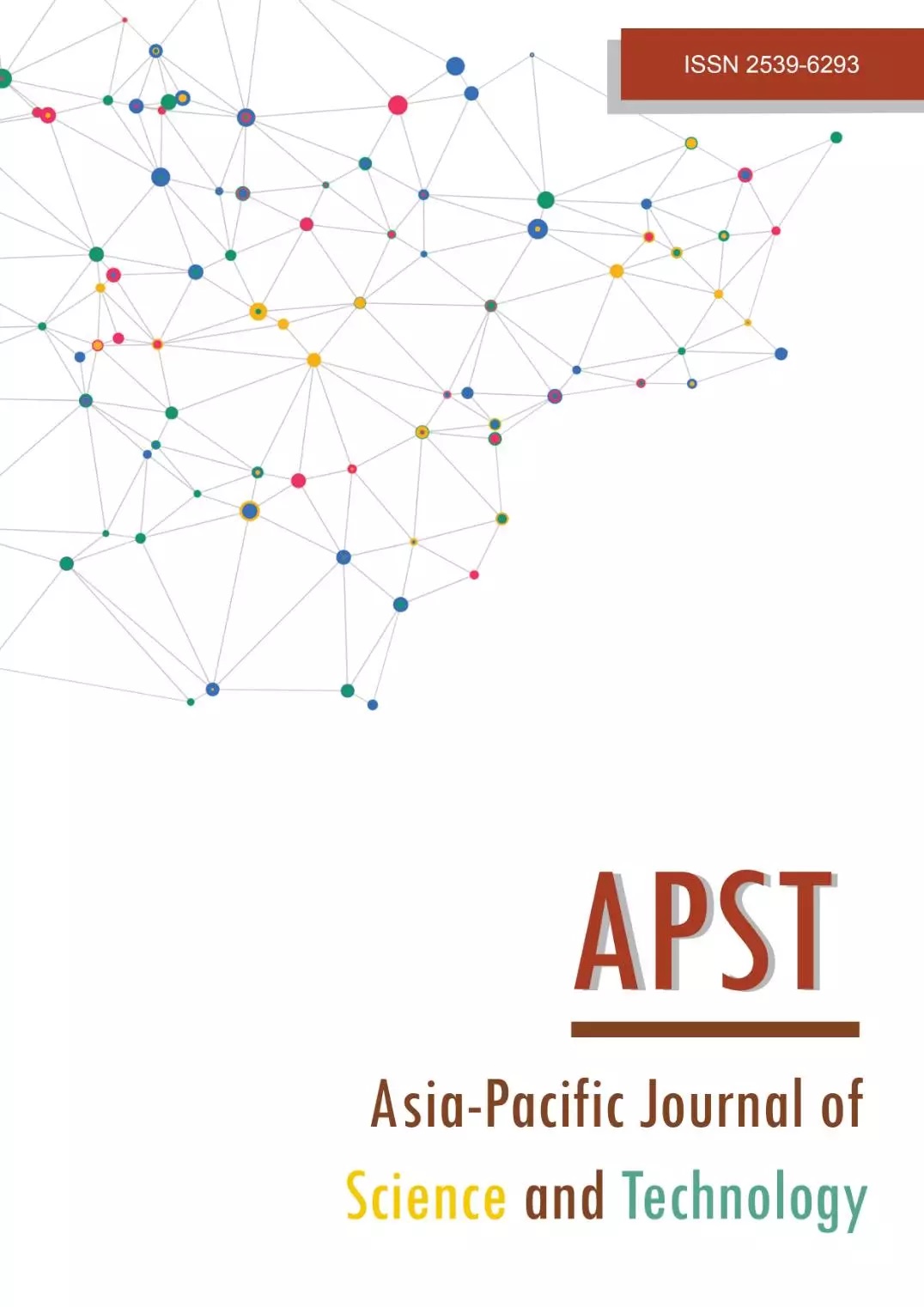Antimicrobial activity of encapsulated spent coffee ground extract-incorporated chitosan films
Main Article Content
Abstract
This work aimed to compare antimicrobial activity of chitosan films containing encapsulated (eSCGE-CH film) and non-encapsulated spent coffee ground aqueous extracts (SCGE-CH film). Chitosan films with eSCGE and SCGE at SCGE equivalent concentrations of 0, 0.5, 0.75 and 1.0% (w/v) were prepared. The antimicrobial activity of eSCGE-CH and SCGE-CH films were evaluated by a drop-test method against some potent food pathogens, including Gram-positive bacteria. (Staphylococcus aureus TISTR2329 and Bacillus subtilis TISTR1984) and Gram-negative bacteria (Escherichia coli TISTR527 and Salmonella typhimurium TISTR2519). The eSCGE-CH film showed a higher inhibitory effect against S. aureus B. subtilis and S. typhimurium than the SCGE-CH film, with S. typhimurium being the most susceptible bacteria compared to the others (p ≤ 0.05). These results indicate that encapsulation could enhance the antimicrobial activity of the SCGE in the CH film suggesting the potential feasibility of the eSCGE-CH film as an antimicrobial packaging for food applications.
Article Details

This work is licensed under a Creative Commons Attribution-NonCommercial-NoDerivatives 4.0 International License.
References
Esquivel P, Jiménez VM. Functional properties of coffee and coffee by-products. Food Res Int. 2012;46(2):488-495.
Sousa C, Gabriel C, Cerqueira F, Manso MC, Vinha A. Coffee industrial waste as a natural source of bioactive compounds with antibacterial and antifungal activities. In: Méndez-Vilas A, editor. The battle against microbial pathogens: basic science, technological advances and educational programs. 1st ed. Badajoz: Formatex research center; 2015. p. 131-136.
Monente C, Bravo J, Vitas AI, Arbillaga L, De Peña MP, Cid C. Coffee and spent coffee extracts protect against cell mutagens and inhibit growth of food-borne pathogen microorganisms. J Funct Foods. 2015;12:365-374.
Potter NN, Hotchkiss JH. Food deterioration and its control. 5th ed. Boston: Springer; 1995.
Rocha M, Ferreira FA, Souza MM, Prentice C. Antimicrobial films: a review. In: Méndez-Vilas A, editor. Microbial pathogens and strategies for combating them: science, technology and education. 4th ed. Badojoz: Formatex Research Center; 2013. p. 23-31.
Zhang H, Li X, Kang H. Chitosan coatings incorporated with free or nano-encapsulated Paulownia Tomentosa essential oil to improve shelf-life of ready-to-cook pork chops. LWT Food Sci Technol. 2019;116:1-8.
Siripatrawan U, Harte BR. Physical properties and antioxidant activity of an active film from chitosan incorporated with green tea extract. Food Hydrocoll. 2010;24(8):770-775.
Madene A, Jacquot M, Scher J, Desobry S. Flavour encapsulation and controlled release - a review. Int J Food Sci Technol. 2006;41:1-21.
Desai KG, Park H. Recent developments in microencapsulation of food ingredients. Dry Technol. 2005;23:1361-1394.
Chen H, Li L, Ma Y, McDonald TP, Wang Y. Development of active packaging film containing bioactive components encapsulated in β-cyclodextrin and its application. Food Hydrocoll. 2019;90:360-366.
Araújo CdS, Vimercati WC, Macedo LL, Saraiva SH, Teixeira LJQ, da Costa JMG, et al. Encapsulation of phenolic and antioxidant compounds from spent coffee grounds using spray-drying and freeze-drying and characterization of dried powders. J Food Sci. 2022;87(9):4056-4067.
Xiao Z, Xia J, Zhao Q, Niu Y, Zhao D. Maltodextrin as wall material for microcapsules: a review. Carbohydr Polym. 2022;298:1-18.
Abedi AS, Rismanchi M, Moosavi MH, Khaneghah AM, Mohammadi A, Mahmoudzadeh M. A mixture of modified starch and maltodextrin for spray drying encapsulation of nigella sativa seeds oil containing thymoquinone. Starch. 2021;73(3-4):1900255.
Mazumder RMA, Ranganathan TV. Encapsulation of isoflavone with milk, maltodextrin and gum acacia improves its stability. Curr Res Food Sci. 2020;2:77-83.
Ding WY, Zheng SD, Qin Y, Yu F, Bai JW, Cui WQ, et al. Chitosan grafted with β-cyclodextrin: synthesis, characterization, antimicrobial activity, and role as absorbefacient and solubilizer. Front Chem. 2019;6:1-14.
Sendi FS, Fatikha TS, Rizqi H, Dwiarso R. Microencapsulation of Kaffir (Citrus Hystrix DC) essential oil using chitosan and maltodextrin coatings with freeze drying process as anti cellulitis. Eksakta J Sci Data Anal. 2023;4(1):1-10.
Khotchapong W. Optimization of spent coffee ground extract encapsulation [dissertation]. Chonburi: Burapha university; 2019.
Aprilia A, Jaisan C, Punbusayakul N. Antimicrobial and antioxidant activities of microwave-assisted extracts from coffee ground residue. In: Rimando AM, Mahattanatawee K, editors. The 1st Joint ACS AGFD-ACS ICSCT Symposium on Agricultural and Food Chemistry; 2014 March 4-5; Bangkok: Thailand. Washington: American Chemical Society; 2015. p. 292-298.
Jaisan C, Punbusayakul N. Development of coffee pulp extract-incorporated chitosan film and its antimicrobial and antioxidant activities. KKU Res J. 2016;21 Suppl 14:140-149.
Clinical and Laboratory Standards Institute (CLSI). Performance standards for antimicrobial disk susceptibility tests; approved standard. 9th ed. Wayne: CLSI; 2019.
Sun SQ, Sun B, Zhang W, Wang D. Preparation and antibacterial activity of Ag-TiO2 composite film by liquid phase deposition (LPD) method. Bull Mater Sci. 2008;31(1):61-66.
Herigstad B, Hamilton M, Heersink J. How to optimize the drop plate method for enumerating bacteria. Journal of microbiological methods. 2001;44(2):121-129.
Kumar SUU, Paridah MT, Owolabi FAT, Gopakumar DA, Rizal S, Amirul AA, et al. Neem leaves extract based seaweed bio-degradable composite films with excellent antimicrobial activity for sustainable packaging material. Bioresour. 2019;14:700-713.
Okur I, Soyler B, Sezer P, Oztop MH, Alpas H. Improving the recovery of phenolic compounds from spent coffee grounds (SCG) by environmentally friendly extraction techniques. Molecules. 2021;26(3):613.
Lou Z, Wang H, Zhu S, Ma C, Wang Z. Antibacterial activity and mechanism of action of chlorogenic Acid. J Food Sci. 2011;76(6):M398-M403.
Yilmaz Atay H. Antibacterial activity of chitosan-based systems. In: Jana S, editor. Functional chitosan. 1st ed. Singapore: Springer; 2020. p. 457-489.
Getachew AT, Ahmad R, Park JS, Chun BS. Fish skin gelatin based packaging films functionalized by subcritical water extract from spent coffee ground. Food Packag Shelf Life. 2021;29:1-11.
Da Silva NC, Assis OBG, Sartori AGO, De Alencar SM, Martelli-Tosi M. Chitosan suspension as extractor and encapsulating agent of phenolics from acerola by-product. Food Res Int. 2022;161:1-8.
Negi A, Kesari KK. Chitosan nanoparticle encapsulation of antibacterial essential oils. Micromachines. 2022;13(8):1-34.
Paomephan P, Assavanig A, Chaturongakul S, Cady NC, Bergkvist M, Niamsiri N. Insight into the antibacterial property of chitosan nanoparticles against Escherichia coli and Salmonella typhimurium and their application as vegetable wash disinfectant. Food Control. 2018;86:294-301.


